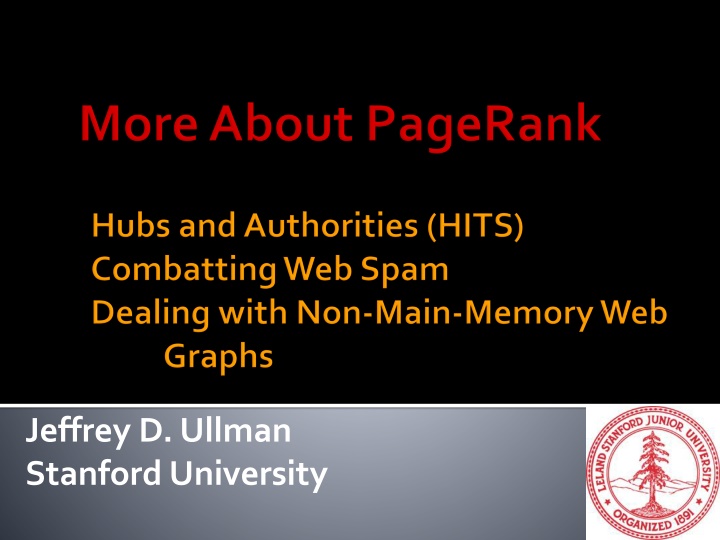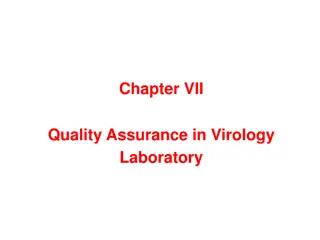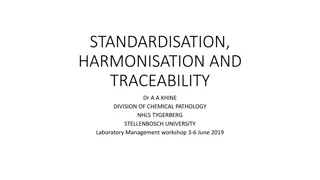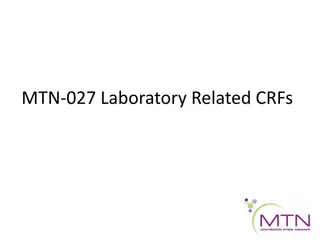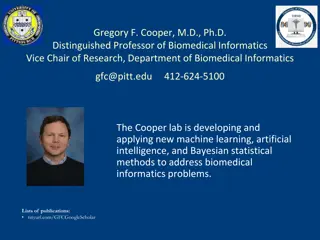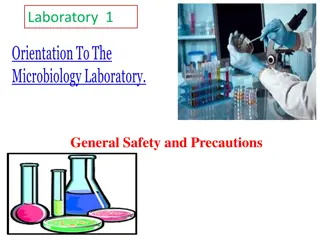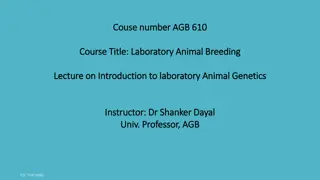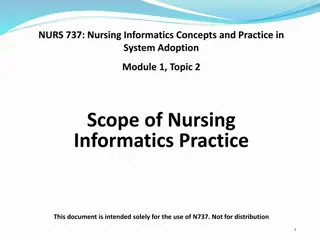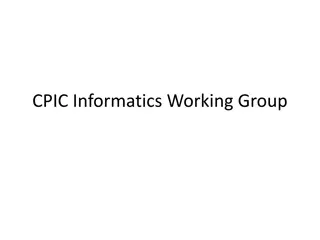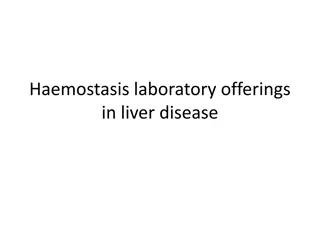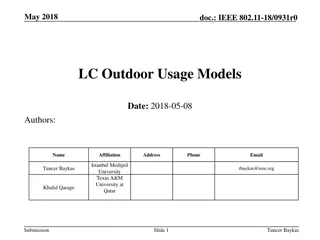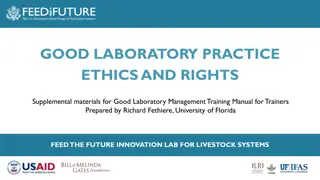Environmental Laboratory Informatics: Team LabRats and Solutions
NAU's environmental engineering labs serve teaching, research, and special projects in biotechnology, construction, transportation, and water/soil analysis. The current lack of organization and coordination poses potential hazards. The team addresses these issues by simplifying processes, integrating systems, and ensuring future extensibility. By working closely with client Terry Baxter, PhD, they plan to streamline lab processes and enhance safety protocols.
Download Presentation

Please find below an Image/Link to download the presentation.
The content on the website is provided AS IS for your information and personal use only. It may not be sold, licensed, or shared on other websites without obtaining consent from the author.If you encounter any issues during the download, it is possible that the publisher has removed the file from their server.
You are allowed to download the files provided on this website for personal or commercial use, subject to the condition that they are used lawfully. All files are the property of their respective owners.
The content on the website is provided AS IS for your information and personal use only. It may not be sold, licensed, or shared on other websites without obtaining consent from the author.
E N D
Presentation Transcript
Jeffrey D. Ullman Stanford University
Mutually recursive definition: A hub links to many authorities; An authority is linked to by many hubs. Authorities turn out to be places where information can be found. Example: course home pages. Hubs tell where the authorities are. Example: departmental course-listing page. 3
HITS uses a matrix A[i, j] = 1 if page i links to page j, 0 if not. AT, the transpose of A, is similar to the PageRank matrix M, but AThas 1 s where M has fractions. Also, HITS uses column vectors h and a representing the degrees to which each page is a hub or authority, respectively. Computation of h and a is similar to the iterative way we compute PageRank. 4
y a m Yahoo y 1 1 1 a 1 0 1 m 0 1 0 A = Amazon M soft 5
Powers of A and AThave elements whose values grow exponentially with the exponent, so we need scale factors and . Let h and a be column vectors measuring the hubbiness and authority of each page. Equations: h = Aa; a = AT h. Hubbiness = scaled sum of authorities of successor pages (out-links). Authority = scaled sum of hubbiness of predecessor pages (in-links). 6
From h = Aa; a = AT h we can derive: h = AAT h a = ATA a Compute h and a by iteration, assuming initially each page has one unit of hubbiness and one unit of authority. Pick an appropriate value of . 7
Remember: it is only the direction of the vectors, or the relative hubbiness and authority of Web pages that matters. As for PageRank, the only reason to worry about scale is so you don t get overflows or underflows in the values as you iterate. 8
a = ATA a; h = AAT h 1 1 1 3 2 1 2 1 2 1 1 0 AAT= 2 2 0 ATA= 1 2 1 A = 1 0 1 AT = 1 0 1 1 1 0 0 1 0 1 0 1 2 1 2 1+ 3 2 1+ 3 . . . . . . . . . = = = 1 1 1 5 4 5 24 18 24 114 84 114 a(yahoo) a(amazon) a(m soft) . . . . . . . . . h(yahoo) h(amazon) h(microsoft) = = = 1 1 1 6 4 2 132 96 36 1.000 0.735 0.268 28 20 8 9
Iterate as for PageRank; dont try to solve equations. But keep components within bounds. Example: scale to keep the largest component of the vector at 1. Consequence is that and actually vary as time goes on. 10
Correct approach: start with h= [1,1,,1]; multiply by ATto get first a; scale, then multiply by A to get next h, and repeat until approximate convergence. You may be tempted to compute AAT and ATA first, then iterate multiplication by these matrices, as for PageRank. Bad, because these matrices are not nearly as sparse as A and AT. 11
Spamming = any deliberate action solely in order to boost a Web page s position in search- engine results. Spam = Web pages that are the result of spamming. SEO industry might disagree! SEO = search engine optimization
Boosting techniques. Techniques for achieving high relevance/importance for a Web page. Hiding techniques. Techniques to hide the use of boosting from humans and Web crawlers.
Term spamming. Manipulating the text of web pages in order to appear relevant to queries. Link spamming. Creating link structures that boost PageRank.
Repetitionof terms, e.g., Viagra, in order to subvert TF.IDF-based rankings. Dumping = adding large numbers of words to your page. Example: run the search query you would like your page to match, and add copies of the top 10 pages. Example: add a dictionary, so you match every search query. Key hiding technique: words are hidden by giving them the same color as the background. 16
PageRank prevents spammers from using term spam to fool a search engine. While spammers can still use the techniques, they cannot get a high-enough PageRank to be in the top 10. Spammers now attempt to fool PageRank by link spam by creating structures on the Web, called spam farms, that increase the PageRank of undeserving pages. 18
Three kinds of Web pages from a spammers point of view: 1. Own pages. Completely controlled by spammer. 2. Accessible pages. E.g., Web-log comment pages: spammer can post links to his pages. 3. Inaccessible pages. Everything else. 19
Spammers goal: Maximize the PageRank of target page t. Technique: 1. Get as many links as possible from accessible pages to target page t. 2. Construct a spam farm to get a PageRank- multiplier effect. 20
Accessible Own 1 Inaccessible 2 t M Note links are 2-way. Page t links to all M pages and they link back. Goal: boost PageRank of page t. One of the most common and effective organizations for a spam farm. 21
Own Accessible 1 2 Inaccessible t M Suppose rank from accessible pages = x. PageRank of target page = y. Taxation rate = 1- Rank of each farm page = y/M + (1- )/N. Share of tax ; N = size of the Web. Total PageRank = 1. From t; M = number of farm pages 22
Tax share for t. Very small; ignore. Own Accessible 1 2 Inaccessible t M y = x + M[ y/M + (1- )/N] + (1- )/N y = x + 2y + (1- )M/N y = x/(1- 2) + cM/N where c = /(1+ ) PageRank of each farm page 23
Own Accessible 1 2 Inaccessible t M y = x/(1- 2) + cM/N where c = /(1+ ). For = 0.85, 1/(1- 2)= 3.6. Multiplier effect for acquired page rank. By making M large, we can make y almost as large as we want. 24
If you design your spam farm just as was described, Google will notice it and drop it from the Web. More complex designs might be undetected, but SEO innovations can be tracked by Google et al. Fortunately, there are other techniques that do not rely on direct detection of spam farms. 25
Topic-specific PageRank, with a set of trusted pages as the teleport set is called TrustRank. Spam Mass = (PageRank TrustRank)/PageRank. High spam mass means most of your PageRank comes from untrusted sources you may be link- spam. 26
Two conflicting considerations: Human may have to inspect each trusted page, so this set should be as small as possible. Must ensure every good page gets adequate TrustRank, so all good pages should be reachable from the trusted set by short paths. Implies that the trusted set must be geographically diverse, hence large. 27
1. Pick the top k pages by PageRank. It is almost impossible to get a spam page to the very top of the PageRank order. 2. Pick the home pages of universities. Domains like .edu are controlled. Notice that both these approaches avoid the requirement for human intervention. 28
Google computes the PageRank of a trillion pages (at least!). The PageRank vector of double-precision reals requires 8 terabytes. And another 8 terabytes for the next estimate of PageRank. 30
The matrix of the Web has two special properties: 1. It is very sparse: the average Web page has about 10 out-links. 2. Each column has a single value 1 divided by the number of out-links that appears wherever that column is not 0. 31
Trick: for each column, store n = the number of out-links and a list of the rows with nonzero values (1/n). Thus, the matrix of the Web requires at least (4*1+8*10)*1012 = 84 terabytes. Integer n Average 10 links/column, 8 bytes per row number. 32
Divide the current and next PageRank vectors into k stripes of equal size. Each stripe is the components in some consecutive rows. Divide the matrix into squares whose sides are the same length as one of the stripes. Pick k large enough that we can fit a stripe of each vector and a block of the matrix in main memory at the same time. Note: the multiplication may actually be done at many machines in parallel. 33
w1 M11 M12 M13 v1 = w2 M21 M22 M23 v2 w3 M31 M32 M33 v3 At one time, we need wi, vj, and Mij in memory. Vary v slowest: w1 = M11 v1; w2 = M21 v1; w3 = M31 v1; w1 += M12 v2; w2 += M22 v2; w3 += M32 v2; w1 += M13 v3; w2 += M23 v3; w3 += M33 v3 34
Each column of a block is represented by: 1. The number n of nonzero elements in the entire column of the matrix (i.e., the total number of out- links for the corresponding Web page). 2. The list of rows of that block only that have nonzero values (which must be 1/n). I.e., for each column, we store n with each of the k blocks and the out-link with whatever block has the row to which the link goes. 35
Total space to represent the matrix = (4*k+8*10)*1012 = 4k+80 terabytes. Integer n for a column is represented in each of k blocks. Average 10 links/column, 8 bytes per row number, spread over k blocks. 36
We are not just multiplying a matrix and a vector. We need to multiply the result by a constant to reflect the taxation. We need to add a constant to each component of the result w. Neither of these changes are hard to do. After computing each component wi of w, multiply by and then add (1- )/N. 37
The strategy described can be executed on a single machine. But who would want to? There is a simple MapReduce algorithm to perform matrix-vector multiplication. But since the matrix is sparse, better to treat it as a relational join. 38
Another approach is to use many jobs, each to multiply a row of matrix blocks by the entire v. Use main memory to hold the one stripe of w that will be produced. Read one stripe of v into main memory at a time. Read the block of M that needs to multiply the current stripe of v, a tiny bit at a time. Works as long as k is large enough that stripes fit in memory. M read once; v read k times, among all the jobs. OK, because M is much larger than v. 39
Mi1 v1 wi Main Memory for job i 40
Mi2 v2 wi Main Memory for job i 41
Mij vj wi Main Memory for job i 42
